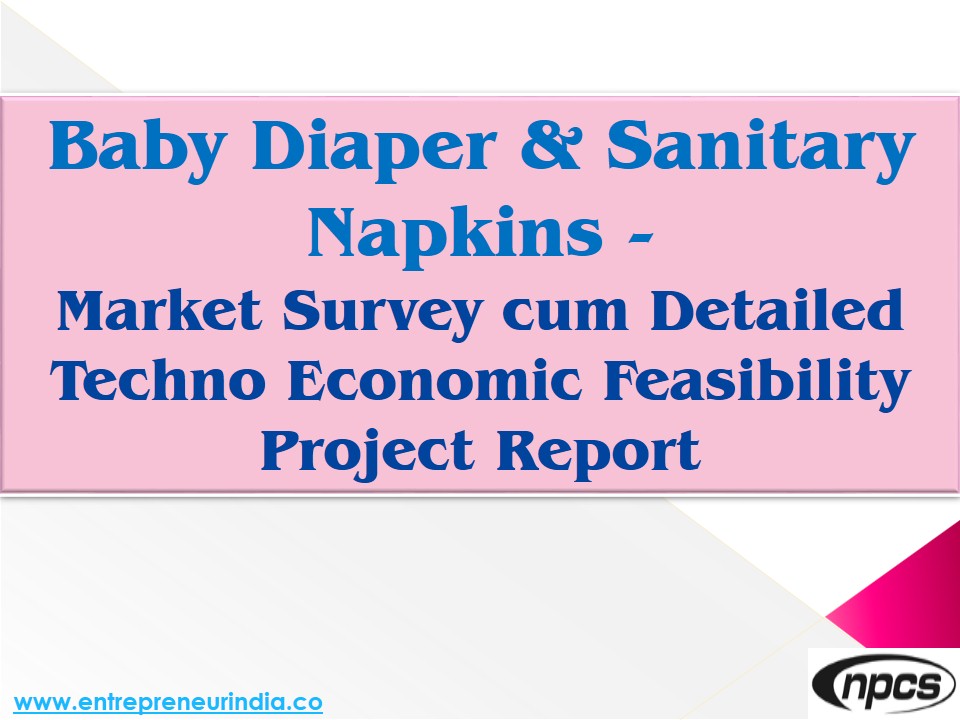
The demand for hygiene products has been rising significantly due to increasing awareness about personal care and hygiene, particularly in developing nations. Consequently, the establishment of a baby diaper and sanitary napkins manufacturing plant has been considered a profitable and socially impactful venture. Moreover, these products have been adopted as essentials in households, hospitals, and maternity centers across both urban and rural regions. As a result, investors have been showing keen interest in setting up plants dedicated to these indispensable consumer items.
Overview of Hygiene Product Industry
In recent years, the hygiene product industry has experienced remarkable growth. Specifically, baby diapers and sanitary napkins have been embraced as daily-use commodities. Not only has the market demand been fueled by increased disposable income, but it has also been influenced by changing lifestyle patterns and greater female workforce participation. Furthermore, awareness campaigns by health organizations have played a vital role in promoting the use of hygienic products.
See Also : Industrial Adhesives Market
Setting Up the Manufacturing Plant
Before the plant is set up, certain prerequisites must be fulfilled. First, a proper feasibility study must be conducted to assess the market scope, availability of raw materials, utility requirements, and skilled labor. Additionally, the location of the plant should be strategically selected, preferably close to transportation hubs and major distribution centers. Subsequently, the land and building setup must be established as per industry standards and pollution control regulations.
Machinery and Equipment Required
Modern machinery plays a crucial role in ensuring the efficient and high-speed production of hygiene products. Therefore, fully automatic or semi-automatic machines are usually preferred for such plants. In the case of baby diaper production, machines are used for fluff pulp formation, SAP (super absorbent polymer) dispensing, top sheet and back sheet layering, elastic attachment, and final packing. Similarly, sanitary napkin machines are equipped with core forming units, adhesive application systems, cutting and sealing units, and automatic packaging modules. Due to technological advancements, these machines can now produce high volumes with minimal human intervention.
Raw Materials for Manufacturing
Several key raw materials are required for the production of diapers and napkins. Typically, the core absorbent layer is made of wood pulp and super absorbent polymer, which can retain liquid efficiently. In addition, polyethylene film is used as a backsheet, while non-woven fabric acts as a top sheet for comfort. For sanitary napkins, release paper, tissue paper, hot-melt adhesives, and breathable film are essential components. Since quality plays a significant role in consumer preference, sourcing standardized raw materials is strongly advised.
Production Process
The production process of baby diapers and sanitary napkins involves several automated stages. Initially, fluff pulp is shredded and blended with SAP to form the absorbent core. Following this, the core is positioned between non-woven top layers and polyethylene back layers. Meanwhile, elastic bands are affixed where required, and the structure is cut and sealed in appropriate shapes and sizes. Ultimately, the finished products are sterilized and packed in hygienic packaging to ensure safety. Throughout the production process, strict quality checks are performed to maintain uniformity and reliability.
Packaging and Distribution
Proper packaging has been recognized as vital for maintaining product hygiene and appeal. Therefore, the use of laminated pouches, printed cartons, or flow wrap packaging is encouraged. As soon as packaging is completed, the products are ready for dispatch to distribution networks such as wholesalers, medical stores, supermarkets, and online platforms. Because consumer preference is influenced by branding and convenience, appealing and informative packaging must be ensured.
Investment & Cost Analysis
While setting up such a plant involves a considerable investment, the returns are promising. The capital investment includes land, machinery, installation, working capital, and licensing costs. Notably, government schemes and subsidies have been provided in several states for health-related manufacturing businesses. Moreover, bank loans and MSME funding schemes can also be availed. Operational costs such as electricity, manpower, maintenance, and raw material procurement must be factored in for financial planning. Nevertheless, due to high product demand and recurring consumption, a steady revenue stream is expected.
Regulatory Approvals and Certifications
Certain regulations must be complied with before commercial production begins. First and foremost, registration under the Factories Act and local municipal authorities is required. Additionally, a Pollution Control Board (PCB) clearance and fire safety certification must be obtained. For sanitary napkins, Bureau of Indian Standards (BIS) guidelines should be followed. Furthermore, ISO 9001 certification can help build consumer trust and ensure quality control. Since hygiene products are sensitive in nature, strict compliance with quality assurance protocols has been advised.
Market Potential and Opportunities
The Indian baby diaper market has been growing at a CAGR of over 15%, while the sanitary napkin segment is witnessing even higher growth rates due to rural penetration. Importantly, schemes such as Beti Bachao Beti Padhao and Swachh Bharat have raised awareness about menstrual hygiene, boosting the demand for sanitary napkins. Besides domestic markets, opportunities also exist in exporting to South Asia, Africa, and the Middle East, where hygiene product access is still limited. Hence, entrepreneurs entering this domain are expected to tap into both national and international markets.
Target Customers and Market Segments
The primary target audience for baby diapers includes parents of infants and toddlers, pediatric hospitals, and childcare centers. On the other hand, the sanitary napkin market targets adolescent girls, women, hospitals, and wellness retailers. Further market segmentation can be done based on product types, such as ultra-thin, pant-style, eco-friendly, and reusable napkins. Because the market is diverse, customized products for urban and rural segments can be developed.
Challenges in the Business
Despite strong market demand, certain challenges have been observed. Firstly, the competition from established brands such as Pampers, Huggies, and Whisper makes market penetration difficult. Secondly, distribution and awareness in remote areas remain a hurdle. Moreover, the rising cost of raw materials can affect margins. However, these challenges can be overcome through effective pricing, product innovation, and strategic marketing.
Sustainability & Eco-Friendly Alternatives
Given the increasing environmental concerns, biodegradable and eco-friendly alternatives have been gaining traction. Plant-based materials, compostable wrappers, and reusable cloth diapers are being explored. Entrepreneurs entering this space have been advised to invest in R&D for developing sustainable hygiene solutions. Furthermore, compliance with environmental norms can enhance brand credibility and long-term profitability.
Digital Marketing and Branding Strategy
In today’s digital age, strong branding and online presence have been viewed as essential for success. Therefore, social media platforms, e-commerce portals, influencer marketing, and SEO strategies should be utilized for brand promotion. In addition, awareness campaigns regarding hygiene and product education can build customer loyalty. Because first-time users often rely on peer reviews, the availability of product information online is considered highly beneficial.
Financial Projections
Within a span of 2–3 years, break-even is expected for a medium-sized unit. Depending on the scale and automation, monthly production capacities can vary from 200,000 to 1 million units. Sales turnover, gross profit margins, and ROI tend to improve steadily with consistent quality and market presence. Although marketing costs are initially high, economies of scale soon reduce operational expenses.
Future Outlook
The future of the hygiene product industry is promising. With increasing birth rates, female literacy, and healthcare access, the demand for diapers and sanitary napkins is expected to remain robust. Innovations in product design, comfort, and affordability will drive consumer choice. Hence, entrepreneurs entering this industry have been presented with sustainable long-term opportunities.
See Also : Industrial Fasteners
Conclusion
To summarize, the establishment of a baby diaper and sanitary napkins manufacturing plant has been recognized as a lucrative and socially beneficial venture. Through effective planning, regulatory compliance, and strategic marketing, long-term growth and profitability can be ensured. Even though certain challenges may exist, they can be mitigated through innovation, quality assurance, and sustainable practices. Therefore, this segment has been considered ideal for aspiring entrepreneurs looking to make a meaningful impact in both health and business sectors.





